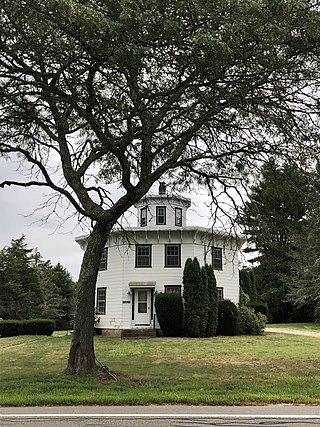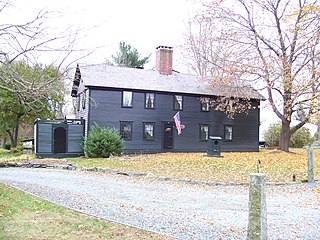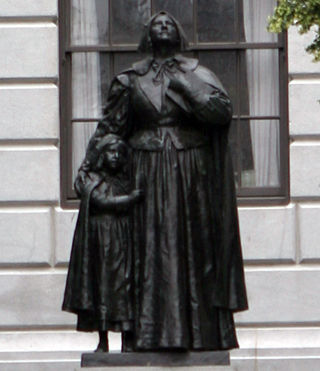
South Kingstown is a town in, and the county seat of, Washington County, Rhode Island, United States. The population was 31,931 at the 2020 census. South Kingstown is the second largest town in Rhode Island by total geographic area, behind New Shoreham, and the third largest town in Rhode Island by geographic land area, behind Exeter and Coventry.

Wakefield is a village in the town of South Kingstown, Rhode Island, United States, and the commercial center of South Kingstown. Together with the village of Peace Dale, it is treated by the U.S. Census as a component of the census-designated place identified as Wakefield-Peacedale, Rhode Island. West Kingston, another South Kingstown village, was the traditional county seat of Washington County. Since 1991, the Washington County Courthouse has been in Wakefield. The Sheriff's Office which handles corrections is also in Wakefield.

Peace Dale is a village in the town of South Kingstown, Rhode Island. Together with the village of Wakefield, it is treated by the U.S. Census as a component of the census-designated place identified as Wakefield-Peacedale, Rhode Island.

Kingston is a village and a census-designated place within the town of South Kingstown in Washington County, Rhode Island, United States, and the site of the main campus of the University of Rhode Island. The population was 6,974 at the 2010 census. Much of the village center is listed on the National Register of Historic Places as Kingston Village Historic District. It was originally known as Little Rest.

Isaac Peace Rodman was a Rhode Island banker and politician, and a Union Army brigadier general in the American Civil War, mortally wounded at the Battle of Antietam.

Saunderstown is a small village and historic district in the towns of Narragansett and North Kingstown in Washington County, Rhode Island, United States. Saunderstown has its own post office with the ZIP Code of 02874, which also includes a small part of South Kingstown. Its population is 6,245.

Carolina is a village that straddles the border of the towns of Charlestown and Richmond on the Pawcatuck River in Washington County, Rhode Island. Rhode Island Route 112 passes through the village. Carolina is identified as a census-designated place, with a population of 970 at the 2010 census.

The Captain John Mawdsley House, located at 228 Spring Street, is one of the oldest houses in Newport, Rhode Island.

The Whipple–Jenckes House is a historic American Colonial house at the corner of Diamond Hill Road and Fairhaven Road in Cumberland, Rhode Island. The house was built around the year 1750, enlarged slightly in 1780, and added to the National Register of Historic Places in 1992.

The George Fayerweather Blacksmith Shop is an historic homestead and blacksmith shop at 1859 Mooresfield Road on the eastern outskirts of the Kingston Historic District in South Kingstown, Rhode Island. It was the home of George Fayerweather, an African-American blacksmith and his family, including his wife Sarah Harris Fayerweather. The shop was built in 1820 and was added to the National Register of Historic Places in 1984. The property is maintained by the Kingston Improvement Association, a non-profit organization of local residents, and is now the home of the Fayerweather Craft Guild and the Kingston Garden Club.

The William Davis Miller House also known as the Wakefield Mansion is a historic estate in the Wakefield village of South Kingstown, Rhode Island. The estate consists of 10.7 acres (4.3 ha) of land, on which stand a substantial house, garage and water tank, all built in the mid-1930s. The property was designed by Providence architect Albert Harkness and built for William Davis Miller and Mary (Chew) Miller. Miller was a social and civic force in Providence, serving as a trustee of Brown University, the Providence Public Libraries, and as president of the Rhode Island Historical Society, and was a longtime friend of Harkness. The Colonial Revival estate Harkness designed for the Millers typifies the type of country estates that were built in Rhode Island in the period.

The Stephen Northup House is a historic house at 99 Featherbed Lane in North Kingstown, Rhode Island.

The Commodore Oliver Perry Farm is an historic farm on United States Route 1 in South Kingstown, Rhode Island. The farm consists of 250 acres (100 ha) of rolling fields and woodlands on the west side of the road. The main farm complex includes a wood-frame house, barn, a caretaker's residence, and a number of other outbuildings, accessed via a winding private lane. The main house, a two-story gambrel-roofed structure, is of uncertain construction date, and is generally dated to either 1785 or 1815. It has been extensively altered, and been the subject of well-meaning but historically problematic restorations in the first half of the 20th century.

Six Principle Baptist Church is a historic church in North Kingstown, Rhode Island. As of 2009 it was one of the last surviving historical congregations of the Six Principle Baptist denomination and one of the oldest churches in the United States.

The Kent County Courthouse, now the East Greenwich Town Hall, is a historic court building at 127 Main Street in East Greenwich, Rhode Island.

Governor Henry Bull House, in Newport, Rhode Island was purported to be the oldest house in Rhode Island, with parts of the house dating to 1639. It was destroyed by fire in December 1912.
Henry Bull (1610–1694) was an early colonial Governor of Rhode Island, serving for two separate terms, one before and one after the tenure of Edmund Andros under the Dominion of New England. Sailing from England as a young man, Bull first settled in Roxbury in the Massachusetts Bay Colony, but soon became a follower of the dissident ministers John Wheelwright and Anne Hutchinson, and was excommunicated from the Roxbury church. With many other followers of Hutchinson, he signed the Portsmouth Compact, and settled on Aquidneck Island in the Narragansett Bay. Within a year of arriving there, he and others followed William Coddington to the south end of the island where they established the town of Newport.

Susanna Cole was the lone survivor of an American Indian attack in which many of her siblings were killed, as well as her famed mother Anne Hutchinson. She was taken captive following the attack and held for several years before her release.

Stone, Carpenter & Sheldon was an American architectural firm based in Providence, Rhode Island. Established in 1906 and dissolved in 1926, it was the successor firm to Stone, Carpenter & Willson.


















